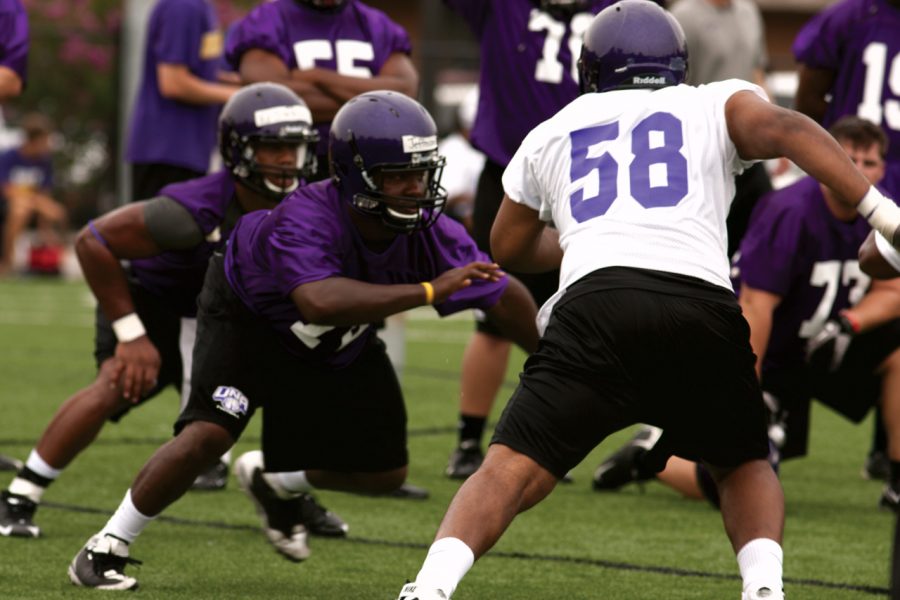UNA and Division I
August 25, 2011
UNA officials spent the summer informing the Shoals about the possible move to Division I athletics by meeting with civic leaders, alumni, students and others to clear up misconceptions related to the transition.
The UNA board of trustees voted 6-3 in June in favor of moving to D-I athletics. In February, more than 1,700 students took part in a student referendum run by the SGA. The majority of those students voted against the move.
“We are not looking at joining the SEC,” said Mark Linder, director of athletics. “I think people believe we will be playing the Alabamas and the Auburns on a weekly basis, but we are not looking at joining the SEC, PAC 12 or not even the Sun Belt.”
Linder said many people are still thinking of when Division I was split between IA and IAA, which is not the case today. The Division I landscape is now split between FCS and FBS, he said.
FCS would be the branch of Division I that UNA would be involved in if the university makes the transition successfully. FBS is what many SEC teams in Alabama play in, including Auburn University and the University of Alabama.
Linder and Alan Medders, vice president of University Advancement, said one of the biggest misconceptions regarding the Division I transition is the amount of money UNA needs to raise to finance the move.
“People think we need $3.5 million by tomorrow, and that’s not the case,” Linder said. “We think we can find people that are excited about our transition and will jump on board.”
Linder and Medders hope to raise $500,000 in the next 90-100 days and find 500 people to invest $1,000 for the year. They also want to create a 45-60 member advisory committee made up of community members, UNA employees and civic leaders.
Medders said the advisory committee’s goal would be to get $500,000 in hand this year, and the next five years.
“(The advisory committee) helps create a culture of giving,” Medders said. “It gets a group of individuals that are passionate.”
Linder said a big misconception about Division I is that UNA will have to improve and buy new facilities.
“We are going to want to improve our facilities, but that has nothing to do with Division I,” he said. “We just want to have the best playing surfaces for our student athletes. There is no attendance requirement for Division I BCS or FCS. We are wanting to improve our facilities and we already started that by adding a new practice field and soccer field.”
UNA officials said the reason they want to transition to Division I at this time is to control their own destiny. They said UNA couldn’t wait on more money from Montgomery, or for the Gulf South Conference to repopulate its membership.
According to UNA officials, there are 20 Division I institutions within 3.5 hours of the Shoals, and there are only six Division II institutions within the same distance. Linder said this fact alone is a huge reason UNA needs to change conferences.
The Ohio Valley Conference, the conference in which UNA officials want the university to move into, visited the UNA campus last Wednesday. The OVC was at UNA for an on-site visit to see the campus and athletic facilities, said UNA spokesman Josh Woods.
“Our campus is a beautiful campus, and we felt like anybody that looks at our campus comes away impressed,” Linder said last week after the OVC visit.
The OVC recently added Belmont University to its conference, which brings the total number of schools in the OVC to 12 institutions.
“I think it helps our chances [having Belmont in the OVC], because right now [the OVC has] nine teams in football and 12 in basketball,” Linder said. “Adding us would give them 10, making it perfect for scheduling in a conference.”
UNA officials have set four benchmarks for the university to transition toward Division I, starting with fulfilling all NCAA Division I membership requirements. The NCAA requirements include paying the application fee, receiving a conference invitation and adding two sports to the current athletics program.
In addition to the NCAA requirements, the board of trustees capped institutional spending for athletics at 4 percent. The 4 percent cap is one of the benchmarks the university has set for itself.
Medders said that the cap the trustees put on athletic spending would protect academic funding and ensure that no money intended for academics could end up going to athletics.
In addition, UNA has instituted a phased-in student fee that will not exceed $8 per credit hour. They also have set a goal of raising $3 million during a five-year period, which comes to $500,000 per year.
Many members of UNA’s coaching staff are excited about the Division I transition.
UNA head football coach Terry Bowden said there are some challenges the university will face during the D-I transition.
“Being able to upgrade the facilities will be one of the challenges (we face) because once you move up to the next level , you need the top facilities to be able to bring in the top players,” he said.
“Just having the opportunity to play against the top teams in Division I and being able to play the high profile universities,” said Mike Keehn, head baseball coach.
Keehn said the biggest challenge for him will be recruiting during the transition period and not being able to play in any post-season games.
“Just seeing the university grow and seeing the new buildings added and seeing the community grow around us is what will be exciting,” said Terry Fowler, head women’s basketball coach. “The transition period will be hard, but it opens the door to a lot more players, but they have to realize that this Division I period is a lot bigger than all of us.”
John Huguley, of Sheffield, is a local resident who has taken a stance against UNA’s decision to move toward Division I athletics.
“I feel like eventually [the university] will go up on prices because of the move, even when they say they are not going to raise tuition at this time,” Huguley said.











